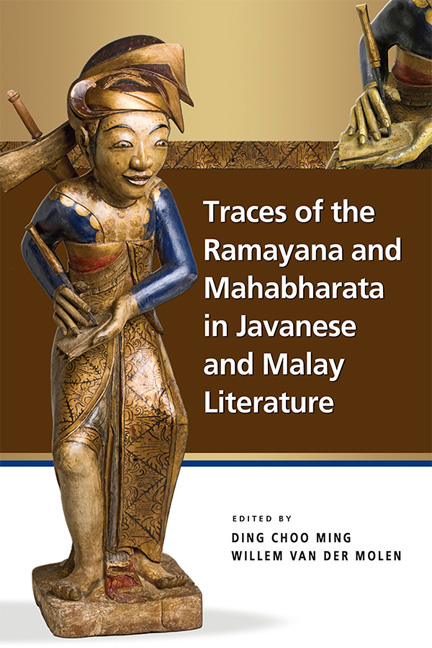Book contents
- Frontmatter
- Contents
- Abbreviations
- About the Contributors
- 1 Introduction
- 2 The Rāmāyaṇa in Java and Bali: Chapters from its Literary History
- 3 Abimanyu Gugur: The Death of Abimanyu in Classical and Modern Indonesian and Malay Literature
- 4 Drona's Betrayal and Bima's Brutality: Javanaiserie in Malay Culture
- 5 Ramayana and Mahabharata in Hikayat Misa Taman Jayeng Kusuma
- 6 The Death of Śalya: Balinese Textual and Iconographic Representations of the Kakawin Bhāratayuddha
- 7 The Illustrated Asṭabrata in Pakualaman Manuscript Art
- Index
- Nalanda-Sriwijaya Series
6 - The Death of Śalya: Balinese Textual and Iconographic Representations of the Kakawin Bhāratayuddha
Published online by Cambridge University Press: 04 July 2018
- Frontmatter
- Contents
- Abbreviations
- About the Contributors
- 1 Introduction
- 2 The Rāmāyaṇa in Java and Bali: Chapters from its Literary History
- 3 Abimanyu Gugur: The Death of Abimanyu in Classical and Modern Indonesian and Malay Literature
- 4 Drona's Betrayal and Bima's Brutality: Javanaiserie in Malay Culture
- 5 Ramayana and Mahabharata in Hikayat Misa Taman Jayeng Kusuma
- 6 The Death of Śalya: Balinese Textual and Iconographic Representations of the Kakawin Bhāratayuddha
- 7 The Illustrated Asṭabrata in Pakualaman Manuscript Art
- Index
- Nalanda-Sriwijaya Series
Summary
IN MEMORIAM
Supomo Suryohudoyo (12-8-1931 – 8-7-2016)
The twelfth-century Kakawin Bhāratayuddha (“The War of the Bhāratas”) is unique in Old Javanese kakawin literature because it was the work of two authors, Mpu Sĕḍah and Mpu Panuluh. Mpu Panuluh began his contribution to the poem from Canto 32, at the point in the narrative when Śalya becomes commander-in-chief of the Kaurawa forces. To this part of the text — a poem in its own right within the larger work — the poet gave the name Śalyawadha, “The Death of Śalya”. Mpu Panuluh's section of the kakawin is marked by a number of major diversions from the Sanskrit narrative of the Mahābhārata, including the animosity between Śalya and Aśwatthāmā and the introduction of the figure of Śalya's wife, Satyawatī, who later performs sati, taking her life on the battlefield in order to follow her beloved husband in death. It is precisely these episodes that dominate later Balinese reworkings of the Bhāratayuddha narrative in poetry and art. This chapter examines the narrative continuities between Mpu Panuluh's contribution to the twelfth-century Javanese kakawin and later textual and visual representations produced in Bali.
Keywords: Old Javanese literature, Balinese literature, kakawin, Balinese art, Bhāratayuddha, Mahābhārata, Śalya, Mpu Panuluh.
Introduction
On 6 September 1157 CE, Mpu Sĕḍah, a poet at the court of King Jayabhaya of Kaḍiri, began to compose the Old Javanese kakawin, the Bhāratayuddha, “The War of the Bhāratas”. This long narrative poem of 731 stanzas retells the story of the war between the Pāṇḍawas and the Kaurawas described in the “battle” books of the great Sanskrit epic, the Mahābhārata, that is, from the preparations for battle in the Udyogaparvan (Book 5) to the annihilation of the Kaurawa forces and the slaughter of the five sons of the Pāṇḍawa heroes on the night after the battle from the Sauptikaparvan (Book 10). In the introductory tribute to his patron in Canto 1, Mpu Sĕḍah, who composed the first section of the poem, reveals that his retelling of the story of the great war between the Pāṇḍawas and the Kaurawas is presented in homage to another mighty hero, his patron, King Dharmeśwara, or Jayabhaya, who has vanquished all his enemies (Supomo 1993, pp. 7–8). This kakawin therefore serves also as an allegorical panegyric to the world-conquering East Javanese monarch who ruled from c. 1135 to 1157 CE.
- Type
- Chapter
- Information
- Publisher: ISEAS–Yusof Ishak InstitutePrint publication year: 2018

